
M. NDIAYE ET AL. 209
Figure 6. Fourier spectrum of black laminae signal. The
periods corresponding to the main peaks are indicated in
blue.
Figure 7. Wavelet analysis of black laminae signal.
tervals displaying increasing ENSO frequencies a
4. Conclusions
bine image analysis and signal proc
tion step is the critical part
of
ed sediments
an
5. Acknowledgements
f Strati-signal software fo
CES
[1] M. Ripepe, L. T. Roberts and A. G. Fischer, “Enso and
Sunspot CycleShales from Image
Analysis,” Jo esearch, Vol. 61,
l Tidal Rhythmites in Madre de
inre
separated by comparatively calm periods.
In this work we com-
essing methods to perform a semi-automated analysis on
varved sediment. The interest of varves study, which
presents annual deposition of the couplets, can be found
in paleo climatology studies.
We noted that the classifica
laminated sediments analysis as it depends on the
quality of the input data. Moreover, parameters setting
are widely based on empirical approach.
The methodology developed for laminat
alysis can be easily extended to other fields of geo-
sciences where data pr esent time related laminations such
as stromatolites, tree rings in dendrochronology, ice
cores, etc. to emphasize existence of cyclic events.
Thanks to all beta testers or
the ir feedbacks. Thanks to Nicolas Waldmann a nd A dr ian
Gilli for the Lago Cardiel da ta.
REFEREN
s in Varved Eocene Oil
urnal of Sedimentary R
1991, pp. 1155-1163.
[2] J. Hovikoski, M. Rasanen, M. Gingras, M. Roddaz, S.
Brusset, W. Hermoza, L. R. Pittman and K. Lertola,
“Miocene Semidiurna
Dios, Peru,” Geology, Vol. 33, No. 3, 2005, pp. 177-180.
doi:10.1130/G21102.1
[3] R. Y. Anderson, “Lacustrine Varve Formation through
Time,” Paleogeography, Paleoclimatology, Paleoecology
Vol. 62, No. 1-4, 1988, ,
pp. 215-235.
doi:10.1016/0031-0182(88)90055-7
[4] G. P. Weedon, “Time-Series Analysis and Cyclostrati-
graphy. Examinating Stratigraphic R
mental Cyles,” Cambridge Universityecords of Environ-
Press, Cambridge,
nt Composition and Climatic Change,” Proceed-
from the Oxygen Minimum
2003.
[5] A. J. Nederbragt, J. W. Thurow and R. B. Merrill, “Color
Records from the California Margin: Proxy Indicators for
Sedime
ings of the Ocean Drilling Program, Scientific Results,
Vol. 167, 2000, pp. 319-329.
[6] U. von Rad, M. Schaaf, K. H. Michels, H. Schulz, W. H.
Berger and F. Sirocko, “A 5000-yr Record of Climate
Change in Varved Sediments
Zone off Pakistan, Northeastern Arabian Sea,” Quater-
nary Research, Vol. 51, No. 1, 1999, pp. 39-53.
doi:10.1006/qres.1998.2016
[7] P. Francus and E. Karabanov, “A Computer-Assisted
Thin- Sect ion Study of Lake Baikal Sediments: A
Understanding Sedimentary Tool for
Processes and Deciphering
Their Climatic Signal,” International Journal of Earth
Sciences, Vol. 89, No. 2, 2000, pp. 260-267.
doi:10.1007/s005319900064
[8] M. C. Cooper, “The Use of Digital Image Analysis in the
Study of Laminated Sediments,” Journal o
nology, Vol. 19, No. 1, 1997, f Paleolim-
pp. 33-40.
doi:10.1023/A:1007912417389
[9] M. Ripepe, L. T. Roberts and A. G. Fischer, “Enso and
Sunspot Cycles in Varved Eocene Oil Sh
Analysis,” Journal of Sedimenales from Image
tary Research, Vol. 61,
olimnology, Vol. 28, No. 2, 2002,
1991, pp. 1155-1163.
[10] P. Francus, F. Keimig and M. Besonen, “An Algorithm to
Aid Varve Counting and Measurement from Thin-Sec-
tions,” Journal of Pale
pp. 283-286. doi:10.1023/A:1021624415920
[11] O. Weidlich and M. Bernecker, “Quantification of Depo-
sitional Changes and Paleo-Seismic Activities Next Term
from Laminated Sediments Using Outcrop Data,” Sedi-
mentary Geology, Vol. 166, 2004, pp. 11-20.
doi:10.1016/j.sedgeo.2003.12.004
[12] M. C. Meyer, R. Faber and C. Spotl, “The WinGeol
Lamination Tool: New Software for Rapid,
mated Analysis of Laminated ClSemi-Auto-
imate Archives,” The
Holocene, Vol. 16, No. 5, 2006, pp. 753-761.
doi:10.1191/0959683606hl969rr
[13] A. Gilli, D. Ariztegui, F. S. Anselmetti, J. A. McKenzie,
Copyright © 2012 SciRes. IJG